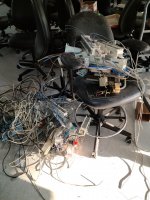electrofelon
Senior Member
- Location
- Cherry Valley NY, Seattle, WA
- Occupation
- Electrician
I've got a three story office building circa 1984 with tons of old phone stuff everywhere. Each floor has around a dozen 66 blocks and of course a mess of tangled phone cables going everywhere. Currently only 1 floor has tenants and pretty much everything else can go. I have a feeling most if not all of these remaining tenants aren't on this old crap, but ya never know. I'd like to get rid of as much of this as possible. I would like to have the owner bring in a phone contractor to identify and demo this stuff, but from past experience, I know that he won't. So to cut down on everyone's frustration for eternity, I'm going to spend some time on this. I am familiar with 66 blocks and testing for active lines with a handset or voltage, but:
Questions:
1. Could someone be getting DSL thru this maze of 66 blocks? How do I test for that? Does it show 50 vdc like POTS?
2. What about something like a T1 line?
3. Any other tips and tricks?
Questions:
1. Could someone be getting DSL thru this maze of 66 blocks? How do I test for that? Does it show 50 vdc like POTS?
2. What about something like a T1 line?
3. Any other tips and tricks?

